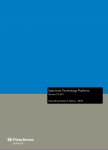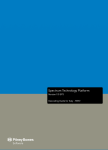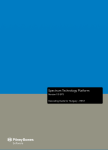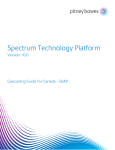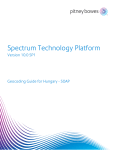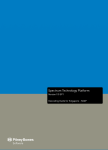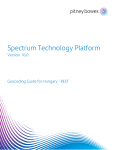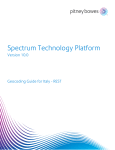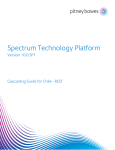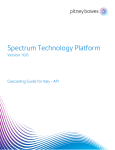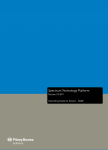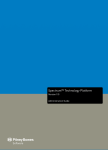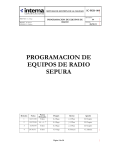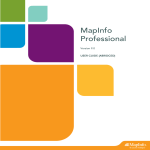Download Geocoding Guide for Argentina
Transcript
Spectrum Technology Platform
Version 9.0 SP3
Geocoding Guide for Argentina - REST
Contents
Chapter 1: GeocodeAddressGlobal...................................................................5
Input........................................................................................................................6
Input Fields...................................................................................................6
Address Input Guidelines.............................................................................7
Single Line Input...........................................................................................8
Street Intersection Input...............................................................................9
Options...................................................................................................................9
Geocoding Options.......................................................................................9
Matching Options........................................................................................12
Data Options...............................................................................................16
Output Data Options...................................................................................17
Output...................................................................................................................17
Address Output...........................................................................................17
Geocode Output.........................................................................................21
Result Codes..............................................................................................21
Chapter 2: ReverseGeocodeAddressGlobal..................................................25
Input......................................................................................................................26
Options.................................................................................................................26
Geocoding Options.....................................................................................26
Matching Options........................................................................................28
Data Options...............................................................................................28
Output...................................................................................................................29
Chapter 3: Result Codes for International Geocoding..................................33
International Street Geocoding Result Codes (S Codes)................................34
Interpreting S Result Codes...............................................................................34
International Postal Geocoding Result Codes (Z Codes)................................35
International Geographic Geocoding Result Codes (G Codes)......................36
Reverse Geocoding Codes (R Codes)...............................................................36
Non-match Codes................................................................................................36
GeocodeAddressGlobal
GeocodeAddressGlobal provides street-level geocoding for many countries. It
can also determine city or locality centroids, as well as postal code centroids.
GeocodeAddressGlobal handles street addresses in the native language and
format. For example, a typical French formatted address might have a street name
of Rue des Remparts. A typical German formatted address could have a street
name Bahnhofstrasse.
Note: GeocodeAddressGlobal does not support U.S. or U.K. addresses. To
geocode U.S. addresses, use GeocodeUSAddress. To geocode U.K.
addresses, use GeocodeAddressGBR.
The countries available to you depends on which country databases you have
installed. For example, if you have databases for Canada, Italy, and Australia
installed, GeocodeAddressGlobal would be able to geocode addresses in these
countries in a single stage. Before you can work with GeocodeAddressGlobal,
you must define a global database resource containing a database for one or
more countries. Once you create the database resource, a GeocodeAddressGlobal
will become available in the Management Console, Enterprise Designer, and
Interactive Driver.
GeocodeAddressGlobal is an optional component of the Enterprise Geocoding
Module.
In this section:
• Input . . . . . . . . . . . . . . . . . . . . . . . . . . . . . . . . . . . . . . . . . . . .6
• Options . . . . . . . . . . . . . . . . . . . . . . . . . . . . . . . . . . . . . . . . .9
• Output . . . . . . . . . . . . . . . . . . . . . . . . . . . . . . . . . . . . . . . . .17
1
Input
Input
GeocodeAddressGlobal takes an address or intersection as input. To obtain the best performance and
the most possible matches, your input address lists should be as complete as possible, free of misspellings
and incomplete addresses, and as close to postal authority standards as possible. Most postal authorities
have websites that contain information about address standards for their particular country.
Input Fields
To obtain the best performance and the most possible matches, your input address lists should be as
complete as possible, free of misspellings and incomplete addresses, and as close to postal authority
standards as possible. Most postal authorities have websites that contain information about address
standards for their particular country.
NAVTEQ data is available for Argentina. For NAVTEQ data, note the following:
Data © 2013 NAVTEQ North America, LLC
The following table lists the input fields used for geocoding locations in Argentina.
Table 1: Input Fields for Argentina
Parameter
Description
Data.AddressLine1
One of the following:
• The address line containing the street name and building number.
For example:
25 De mayo 465
Vied ma, Rio Negro
• This field can also contain the full address. For more information,
see Single Line Input on page 8
Data.AddressLine2
This field is not used in this country.
Data.City
The city or town name. Your input address should use the official city
name or alias. For Argentina, Austria, Bahamas, Czech Republic,
Indonesia, Italy, Mexico, Portugal, Spain, Slovenia, and Switzerland,
you may use the town alias. For example, "Ciudad Autónoma de
Buenos Aires" and "Buenos Aires" are recognized as aliases for
Capital Federal.
Note: In Argentina, Buenos Aires Federal District is not part of
Buenos Aires province. If your input specifies only "Buenos
Aires", Spectrum™ Technology Platform returns candidates
in both the Federal District and in the region of Buenos Aires.
For provincial capitals in Argentina, you can use the word Capital as
well as the actual capital name. For example, input of "Capital, MZA"
is equivalent to "Mendoza, MZA".
Data.Country
The meaning of county varies by country.
• ARG (Argentina)—Department
• USA (United States) —Not used
6
Spectrum Technology Platform 9.0 SP3
Chapter 1: GeocodeAddressGlobal
Parameter
Description
The department name.
Data.FirmName
This field is not used in this country.
Data.HouseNumber
The building number. You may get better parsing results for some
countries if you put the house number in this field instead of
AddressLine1. Not every country includes house number data.
Note: The house number specified in the HouseNumber field takes
precedence over any house number specified in the
AddressLine1 field.
Data.LastLine
The last line of the address.
• 25 De mayo 465
Vied ma, Rio Negro
Data.Locality
The meaning of locality varies by country:
• ARG (Argentina)—Neighborhood or barrio
Data.PostalCode
The postal code in the appropriate format for the country.
Data.StateProvince
The meaning of State/Province varies by country.
• ARG (Argentina)—Region or province
Address Input Guidelines
Follow these suggestions to ensure that your street input data is in the best format possible for optimal
geocoding.
Address Guidelines for Argentina
Follow these suggestions to ensure that your street input data is in the best format possible for optimal
geocoding. For additional information on Argentine addresses, see the Correo Argentino website:
http://www.correoargentino.com.ar/.
• Required fields—If you are using the standard TomTom database, addresses must contain a city.
For the NAVTEQ database, addresses can contain either a city or postal code.
• Thoroughfare types—Thoroughfare types and their common abbreviations are recognized and fully
supported in input addresses. Examples of typical thoroughfare types are:
Avendia
Avendia
Av
Calle
C
Clle
Lateral Ruta
Lat Ruta
LR
Ruta Provincia
RP
RP
Ave
Avda
LR
• Numbers, numeric equivalents, and ordinals—Numbered streets are mapped to the named
equivalents. For example, you can input Calle 5 or Calle cinco and get the same returned candidates.
Ordinals are also recognized in input addresses. The following numbers and equivalents are recognized
as part of a street name input:
1,UNO,PRIMERO,PRIMER,PRIMERA
Geocoding Guide for Argentina - REST
7
Input
5,CINCO,QUINTO,QUINTA
For example, an input street name of "25 de Mayo" is recognized and handled the same way as
"Veinticinco de Mayo".
• Proper names and dates in street and town names—Proper names and dates are often used in
Argentina addresses, and these are handled by MapMarker Argentina. For example, an input street
name of "Juan F. Ibarra" is recognized and handled the same way as "Juan Felipe Ibarra".
• Directionals in addresses—The following directionals are recognized in input addresses: Norte,
Oriente, Este, Sur, Oueste, Occidente, Poniente, N, E, S, O, NE, NO, SE, SO, Noreste, Sudeste,
Noroeste, Sudoeste.
• Abbreviations in addresses—A number of common abbreviations can be used in input addresses.
GeocodeAddress ARG will recognize the abbreviations and geocode successfully. For example,
following is a small sample of equivalent abbreviations. This is not a complete list of address
abbreviations.
Bario
BAR
Ciudad
CD
CD.
Colonia
COL
COL.
Doctor
DR
Francisco
FCO
Manza
MZA
Note: For Argentina, you must use NAVTEQ data for postal geocoding.
Single Line Input
Instead of entering each address element in separate fields, you may enter the entire address in the
AddressLine1 input field.
For all countries except Japan, you can enter addresses in one or more of these single-line formats.
Note: Not all formats work may work for every country.
StreetAddress;PostalCode;City
StreetAddress;City;PostalCode
StreetAddress;City
StreetAddress;City;StateProvince;PostalCode
StreetAddress;Locality
StreetAddress;County;City
PostalCode;StreetAddress
PostalCode;StreetAddress;City
City;PostalCode;StreetAddress
Where:
• StreetAddress can be house number and street name in either order (with street type immediately
before or after the street name).
• City is the city or town.
• Locality is the locality name.
• County is the county (or ename.
• PostalCode is the complete postcode. For Brazil,
8
Spectrum Technology Platform 9.0 SP3
Chapter 1: GeocodeAddressGlobal
Note: Not all of these address elements are used in every country.
Other single-line formats may also be acceptable for many countries.
The matching accuracy for single line input is comparable to that of structured address input. The
performance of single line input addresses may be slightly slower than that of structured address input.
For best results, use delimiters (comma, semicolon, or colon) between each component of the address.
For example,
Capital Federal;Av. Corrientes;3702
If the input address is missing delimiters, spaces are recognized as separators and internal parsing rules
identify address components. In the example above, the address would still successfully geocode even
if some or all of the delimiters were missing in the input.
Note: Non-delimited or partially-delimited single line addresses may take longer to geocode and may
not produce the same results as delimited single line input. This is especially true for addresses
with multi-word street names or cities. To optimize single line geocoding, use delimiters between
address components (particularly between street name and city).
Punctuation is ignored for geocoding purposes.
Guidelines for Single Line Input
• Punctuation is generally ignored, however you may improve results and performance by using
separators (commas, semicolons, etc.) between different address elements.
• The country is not required. Each country geocoder assumes that the address is in its country.
• Firm information (placename, building name, or government building) is returned if available.
Street Intersection Input
If you enter a street intersection as input, the geocoder will provide the coordinates of the intersection.
To enter an intersection, specify the two street names separated by a double ampersand (&&) in
AddressLine1. For some countries, the word AND can also be used to delimit intersections. The &&
delimiter can be used for all countries. For example:
AddressLine1: Calle esmeralda && Calle Marcelo T. Alvea
City: Cordoba
Note: The double ampersand (&&) can always be used as an street intersection separator. For some
countries, you can use additional symbols or words to delimit street intersections.
All close match criteria are enforced for intersection geocoding, just as for any street level geocoding.
Options
Geocoding Options
The following table lists the options that control how a location's coordinates are determined.
Geocoding Guide for Argentina - REST
9
Options
Table 2: Geocoding Options for Argentina
Parameter
Description
Option.GeocodeLevel
Specifies how precisely you want to geocode addresses. One of the
following:
StreetAddress
The geocoder attempts to geocode addresses
to a street address, but some matches may
end up at a less precise location such as a
postal code centroid, intersection, or shape
path.
PostalCentroid
For Argentina, you must use NAVTEQ data for
postal geocoding.
GeographicCentroid The geocoder attempts to geocode addresses
to the geographic centroid of a city or state.
Option.Interpolation
Y
Yes, perform address point interpolation.
N
No, do not perform address point interpolation.
Option.FallbackToGeographic Specifies whether to attempt to determine a geographic region centroid
when an address-level geocode cannot be determined.
Option.FallbackToPostal
Option.OffsetFromStreet
Y
Yes, determine a geographic centroid when an address-level
centroid cannot be determined. Default.
N
No, do not determine a geographic centroid when an
address-level centroid cannot be determined.
For Argentina, you must use NAVTEQ data for postal geocoding.
Y
Yes, determine a postal code centroid when an address-level
centroid cannot be determined. Default.
N
No, do not determine a postal code centroid when an
address-level centroid cannot be determined.
Indicates the offset distance from the street segments to use in
street-level geocoding. The distance is specified in the units you specify
in the OffsetUnits option.
The default value varies by country. For most countries, the default is
7 meters.
The offset distance is used in street-level geocoding to prevent the
geocode from being in the middle of a street. It compensates for the
fact that street-level geocoding returns a latitude and longitude point
in the center of the street where the address is located. Since the
building represented by an address is not on the street itself, you do
not want the geocode for an address to be a point on the street. Instead,
you want the geocode to represent the location of the building which
sits next to the street. For example, an offset of 50 feet means that the
geocode will represent a point 50 feet back from the center of the street.
The distance is calculated perpendicular to the portion of the street
segment for the address. Offset is also used to prevent addresses
across the street from each other from being given the same point.
The following diagram shows an offset point in relation to the original
point.
10
Spectrum Technology Platform 9.0 SP3
Chapter 1: GeocodeAddressGlobal
Parameter
Description
Street coordinates are accurate to 1/10,000 of a degree and
interpolated points are accurate to the millionths of a degree.
Option.OffsetFromCorner
Specifies the distance to offset the street end points in street-level
matching. The distance is specified in the units you specify in the
OffsetUnits option.This value is used to prevent addresses at street
corners from being given the same geocode as the intersection.
Note: Offset is not supported for the United Kingdom (GBR) or Japan
(JPN).
The default value varies by country:
• 12 meters—Australia (AUS), Austria (AUT), Germany (DEU)
• 7 meters—For other supported countries, the default offset is 7
meters.
The following diagram compares the end points of a street to offset
end points.
Option.OffsetUnits
Specifies the unit of measurement for the street offset and corner offset
options. One of the following:
•
•
•
•
Feet
Miles
Meters
Kilometers
The default is Meters.
Option.CoordinateSystem
A coordinate system is a reference system for the unique location of
a point in space. Cartesian (planar) and Geodetic (geographical)
coordinates are examples of reference systems based on Euclidean
geometry. Spectrum™ Technology Platform supports systems
recognized by the European Petroleum Survey Group (EPSG).
Geocoding Guide for Argentina - REST
11
Options
Parameter
Description
Each country supports different coordinate systems. Depending on
the country, you have one or more of the following options:
EPSG:4326
Also known as the WGS84 coordinate
system.
Matching Options
Matching options let you set match restrictions, fallback, and multiple match settings so that the matching
can be as strict or relaxed as you need. The strictest matching conditions require an exact match on
house number, street name, postal code and no fallback to postal code centroids. The geocoder looks
for an exact street address match within the postal code in the input address. Relaxing the conditions
broadens the area in which it searches for a match. For example, by relaxing the postal code, the
geocoder searches for candidates outside the postal code but within the city of your input address.
Table 3: Matching Options for Argentina
Parameter
Description
Option.KeepMultimatch
Specifies whether to return results when the address matches to multiple
candidates in the database. If this option is not selected, an address that
results in multiple candidates will fail to geocode.
If you select this option, specify the maximum number of candidates to
return
Y
Yes, return candidates when multiple candidates are found.
Default.
N
No, do not return candidates. Addresses that result in multiple
candidates will fail to geocode.
Option.MaxCandidates
If you specify KeepMultimatch=Y, this option specifies the maximum
number of results to return. The default is 1. Specify -1 (minus one) to
return all possible candidates.
Option.ReturnRanges
Specifies whether to return address range information. If you enable this
option, the output field Ranges will be included in the output.
A range is a series of addresses along a street segment. For example,
5400-5499 Main St. is an address range representing addresses in the
5400 block of Main St. A range may represent just odd or even addresses
within a segment, or both odd and even addresses. A range may also
represent a single building with multiple units, such as an apartment
building.
Option.MaxRanges
12
Y
Yes, return address range information.
N
No, do not return address range information. Default.
If you choose to return ranges, this option specifies the maximum number
of ranges to return for each candidate. Since the geocoder returns one
candidate per segment, and since a segment may contain multiple ranges,
this option allows you to see the other ranges in a candidate's segment.
Spectrum Technology Platform 9.0 SP3
Chapter 1: GeocodeAddressGlobal
Parameter
Description
Option.MaxRangeUnits
If you choose to return ranges, this option specifies the maximum number
of units (for example, apartments or suites) to return for each range.
For example, if you were to geocode an office building at 65 Main St.
containing four suites, there would be a maximum of four units returned
for the building's range (65 Suite 1, 65 Suite 2, 65 Suite 3, and 65 Suite
4. If you were to specify a maximum number of units as 2, then only two
units would be returned instead of all four.
Option.CloseMatchesOnly
Option.MatchMode
Specifies whether to return only those geocoded results that are close
match candidates. For example, if there are 10 candidates and two of
them are close candidates, and you enable this option, only the two close
matching candidates would be returned instead of all 10. To specify what
is considered a close match, use the options. Address candidates are
ranked according to how closely the input address matches these
preferences.
Y
Yes, return only close matches.
N
No, do not return only close matches. Default.
Specifies how to determine whether a candidate is a close match. One
of the following:
CustomMode This option allows you to specify which parts of a
candidate address must match the input address to be
considered a close match. Use the to specify the
address elements you want. This is the default value
for most countries.
ExactMode
All of a candidate address's elements must match in
order for the candidate to be considered a close match.
CloseMode
Only the candidate address's house number must match
in order for the candidate to be considered a close
match. For Chile, China, Great Britain, Estonia, India,
Indonesia, Latvia, Lithuania, Slovakia, Slovenia, Taiwan,
and South Africa, only the street name and town must
match.
RelaxedMode All candidate addresses are considered a close match.
Option.MustMatchInput
Specifies whether candidates must match all non-blank input fields to be
considered a close match. For example, if an input address contains a
city and postal code, then candidates for this address must match the
city and postal code to be considered a close match.
Y
Yes, a candidate must match all input to be considered a close
match.
N
No, a candidate does not have to match all input to be
considered a close match. Default.
Option.MustMatchHouseNumber Specifies whether candidates must match the house number to be
considered a close match.
If you select this option you should also require an exact match on street
name. This option does not significantly affect performance. It does,
however, affect the type of match if the candidate address corresponds
to a segment that does not contain any ranges. The type of match can
Geocoding Guide for Argentina - REST
13
Options
Parameter
Description
also be affected when the house number range for a candidate does not
contain the input house number. If you relax the house number, you
should set the maximum ranges to be returned to a value higher than 0.
Option.MustMatchStreet
Y
Yes, a candidate must match the house number to be
considered a close match.
N
No, a candidate does not have to match the house number to
be considered a close match.
Specifies whether candidates must match the street name to be
considered a close match.
If a close match is found, the geocoder attempts expanded street name
manipulation, which looks for candidates with names that sound like the
input address or that are spelled improperly. This slows down performance
but increases the match rate . If the geocoding database is indexed, the
performance impact is reduced.
Option.MustMatchLocality
Y
Yes, a candidate must match the street name to be considered
a close match.
N
No, a candidate does not have to match the street name to be
considered a close match.
If you do not require exact matches on locality, the geocoder searches
on the street address matched to the particular postal code, and considers
other localities that do not match the name, but do match the postal code.
• ARG (Argentina)—Neighborhood or barrio
Option.MustMatchCity
Option.MustMatchCounty
Y
Yes, a candidate must match the locality to be considered a
close match.
N
No, a candidate does not have to match the locality to be
considered a close match.
Specifies whether candidates must match the city to be considered a
close match. For Japan, this field specifies whether the candidate must
match the municipality subdivision (oaza). If you do not require exact
matches on city, the geocoder searches on the street address matched
to the particular postal code, and considers other cities that do not match
the name, but do match the postal code.
Y
Yes, a candidate must match the city to be considered a close
match.
N
No, a candidate does not have to match the city to be
considered a close match.
Specifies whether candidates must match the county (or equivalent) to
be considered a close match. The meaning of county varies for different
countries.
• ARG (Argentina)—Department
One of the following:
Y
14
Yes, a candidate must match the county to be considered a
close match.
Spectrum Technology Platform 9.0 SP3
Chapter 1: GeocodeAddressGlobal
Parameter
Description
N
No, a candidate does not have to match the county to be
considered a close match.
Option.MustMatchStateProvince Specifies whether candidates must match the state or province (or
equivalent) to be considered a close match.
• ARG (Argentina)—Region or province
One of the following:
Y
Yes, a candidate must match the state or province to be
considered a close match.
N
No, a candidate does not have to match the state or province
to be considered a close match.
Option.MustMatchPostalCode For Argentina, you must use NAVTEQ data for postal geocoding.
Y
Yes, a candidate must match the postal code to be considered
a close match.
N
No, a candidate does not have to match the postal code to be
considered a close match.
Option.SortCandidatesUsingLocale This is a Reverse geocoding option that applies to Greece, Russia,
Ukraine, and any itger country that supports dual character sets (such
as the Middle East countries).
Specifies whether candidates are sorted and returned based on the input
language. That is, if the input was in Russian, the Russian character
candidate is returned first followed by the English language candidate.
This will override the dictionary order.
Y
Yes, candidates are sorted and returned based on input
language.
N
No, candidates are returned in the order that the dictionary was
added to the database, regardless of input language.
You may want to use a balanced strategy between match rate and geographic precision. That is, you
may want to geocode as many records as possible automatically, but at the same time want to minimize
the number of weaker matches (false positives). For example, false positives can occur when the
geocoder:
• finds a street that sounds like the input street.
• finds the same street in another city (if postal code match is not required).
• finds the street but with a different house number (if house number is not required).
The following settings may achieve a good balance between match rate and precision:
•
•
•
•
CloseMatchesOnly—Specify "Y".
MustMatchHouseNumber—Specify "Y".
MustMatchStreet—Specify "Y".
FallbackToPostal—Specify "N".
Geocoding Guide for Argentina - REST
15
Options
Data Options
The Data tab allows you to specify which databases to use in geocoding. Databases contain the address
and geocode data necessary to determine the geocode for a given address. There are two kinds of
databases: standard databases and custom databases. Standard databases are those supplied by
Pitney Bowes Software and based on address and geocoding data from postal authorities and suppliers
of geographical data. Custom databases are databases you create to enhance or augment standard
databases for your particular needs.
The following table lists the options available for specifying which databases to use and the search order
of databases.
Table 4: Data Options for Argentina
Parameter
Description
Option.Database
Specifies the database to be used for geocoding. Only databases that
have been defined in the Databases Resources panel in the
Management Console are available.
Option.DatabasePreference
Specifies which geocoding databases to use. One of the following:
PreferCustom
Use both standard databases and custom
databases, but give preference to candidates from
custom databases. Use this option if you feel your
custom database is superior to the standard
database.
PreferStandard Use both standard databases and custom
databases, but give preference to candidates from
standard databases.
CustomOnly
Use only custom databases. Ignore standard
databases.
StandardOnly
Use only standard databases. Ignore custom
databases.
Both
Use both standard databases and custom
databases. In cases where candidates are returned
from both, the standard database is preferred.
Default.
The results from a custom database have a "U" at the end of the result
code. Results from an address database have an "A" at the end of the
match score. For example: S5HPNTSCZA is a match score that comes
from an address database, while S5HPNTSCZU comes from a custom
database. For more information, see Result Codes for International
Geocoding on page 33.
Option.DatabaseSearchOrder The name of one or more database resources to use in the search
process. Use the database name specified in the Management Console's
Database Resources tool.
You can specify multiple database resources. If you specify more than
one database, list them in order of preference.
The order of the databases has an effect when there are close match
candidates from different databases. The close matches that are returned
16
Spectrum Technology Platform 9.0 SP3
Chapter 1: GeocodeAddressGlobal
Parameter
Description
come from the database that is first in the search list. Close matches
from lower ranked databases are demoted to non-close matches.
You can also use the order of the databases to perform fallback
processing if you have an both an address point database and a
street-level database installed for the country. List the address point
database first and the street database second. If the address cannot
be geocoded to the address point level, the geocoder will attempt to
geocode it to the street level.
Related Links
GeocodeAddressGlobal on page 5
Output Data Options
The following table lists the options that control which data is returned in the output.
Table 5: Output Data Options
Parameter
Description
Option.ReturnOnlySimilarFirmNames This option applies to the U.K. only.
Specifies whether to return firm names only when the input firm name
is similar to the firm name in the geocoding database. For example, if
the input firm name is "Pitney Bowes Business Insight" but the geocoding
database returns "Pitney Bowes Software, Inc.", these two firm names
are not similar. In most cases the input firm name must match the firm
name in the database exactly. Some differences in abbreviations are
considered similar enough to result in the firm name being returned.
Y
Yes, return only firm names that are similar to the input firm
name.
N
No, return firm names regardless of whether they are close
to the input firm name. Default.
Output
The geocoder returns the latitude/longitude, standardized address, and result indicators. Result indicators
describe how well the geocoder matched the input address to a known address and assigned a location;
they also describe the overall status of a match attempt.
Address Output
The address may be identical to the input address if the input address was accurate, or it may be a
standardized version of the input address, or it may be a candidate address when multiple matches are
found.
Geocoding Guide for Argentina - REST
17
Output
Table 6: Address Output for Argentina
Response Element
Description
AddressLine1
First line of the address.
AddressLine2
Second line of the address.
ApartmentLabel
The type of unit, such as apartment, suite, or lot.
ApartmentNumber
Unit number.
City
The municipality name.
Country
The three-letter ISO 3166-1 Alpha 3 country code.
For Argentina, the country code is ARG.
For Japan, the country code is JPN
Addresses for countries that do not have a dedicated geocoding stage
return the country code associated with the input address. For example,
Vatican City addresses return VAT in the Country field, regardless of
whether VAT or ITA (Italy) was passed as the country code. Similarly,
addresses in Martinique return MTQ (rather than FRA) in the Country
field.
Data.Country
The meaning of county varies by country.
• ARG (Argentina)—Department
• USA (United States) —Not used
The department name.
FirmName
Name of the company or a place name.
HouseNumber
The building number for the matched location.
HouseNumberHigh
The highest house number of the range in which the address resides.
HouseNumberLow
The lowest house number of the range in which the address resides.
HouseNumberParity
Indicates if the house number range contains even or odd numbers or
both.
E
Even
O
Odd
B
Both
U
Unknown
Language
For reverse geocoded candidates, the two-character language code is
returned.
LastLine
Complete last address line (city, state/province, and postal code).
LeadingDirectional
Street directional that precedes the street name. For example, the N in
138 N Main Street.
Data.Locality
The meaning of locality varies by country:
• ARG (Argentina)—Neighborhood or barrio
18
Spectrum Technology Platform 9.0 SP3
Chapter 1: GeocodeAddressGlobal
Response Element
Description
NumberOfCandidateRanges Indicates the number of ranges of which the candidate is a member. A
candidate may be a part of multiple ranges if the candidate is a street
instead of a building.
NumberOfRangeUnits
Indicates the number of units included in the range. A unit is an address
within a building, such as an apartment or office suite.
PostalCode
The postcode for the address. The format of the postcode varies by
country. Postcode data is not available for every country.
PostalCode.Addon
The second part of a postcode. This field is not used by most countries.
PreAddress
Miscellaneous information that appears before the street name.
PrivateMailbox
This field is not currently used.
Ranges
This is a list field containing the address ranges that exist on the street
segment where the candidate address is located.
A range is a series of addresses along a street segment. For example,
5400-5499 Main St. is an address range representing addresses in the
5400 block of Main St. A range may represent just odd or even addresses
within a segment, or both odd and even addresses. A range may also
represent a single building with multiple units, such as an apartment
building.
The Ranges field contains the following sub-fields:
Address
This is a list filed that contains sub-fields for
any address elements (AddressLine1, City,
and so on) that are different from the
candidate's address.
AdditionalFields
A listing of country-specific information
related to the address. The information
contained in AdditionalFields varies by
country.
HouseNumberHigh
The highest address number for the range.
HouseNumberLow
The lowest address number for the range.
SegmentParity
Indicates the side of the street where the
range is located. One of the following:
HouseNumberParity
0
It is not known which side of the
street the range is located on.
1
The range is on the left side of the
street.
2
The range is on the right side of the
street.
Indicates whether the range contains odd
or even address numbers. One of the
following:
0
Geocoding Guide for Argentina - REST
The range contains both odd and
even address numbers.
19
Output
Response Element
Description
1
The range contains odd address
numbers
2
The range contains even address
numbers.
-1
It is not known whether the range
contains odd or even house
numbers.
TotalRangeUnitsReturned The number of unit ranges returned for the
address. A unit is an address within a
building, such as an apartment or suite.
RangeUnits
A list of the ranges of units within the
building. An example of units are
apartments or suites.
Address
This is a list filed that
contains sub-fields for
any address elements
(AddressLine1, City,
and so on) that are
different from the
candidate's address.
UnitNumberHigh The highest unit
number.
UnitNumberLow The lowest unit number.
SegmentCode
A unique ID that identifies a street segment.
SegmentParity
Indicates which side of the street has odd numbers.
Data.StateProvince
L
Left side of the street
R
Right side of the street
B
Both sides of the street
U
Undetermined
The meaning of State/Province varies by country.
• ARG (Argentina)—Region or province
StreetDataType
The default search order rank of the database used to geocode the
address. A value of "1" indicates that the database is first in the default
search order, "2" indicates that the database is second in the default
search order, and so on.
The default database search order is specified in the Management Console
with the Database Resources tool.
20
StreetName
For most countries, this contains the street name.
StreetPrefix
The type of street when the street type appears before the base street
name.
StreetSuffix
The street type of the matched location. For example, AVE for Avenue.
Spectrum Technology Platform 9.0 SP3
Chapter 1: GeocodeAddressGlobal
Response Element
Description
TrailingDirectional
Street directional that follows the street name.
UnitNumberHigh
The highest unit number of the range in which the unit resides.
UnitNumberLow
The lowest unit number of the range in which the unit resides.
Geocode Output
Table 7: Geocode Output for Argentina
Response Element
Description
CoordinateSystem
The coordinate system used to determine the latitude and longitude
coordinates. A coordinate system specifies a map projection, coordinate
units, etc. An example is EPSG:4326. EPSG stands for European
Petroleum Survey Group.
Latitude
Seven-digit number in degrees and calculated to four decimal places
(in the format specified).
Longitude
Seven-digit number in degrees and calculated to four decimal places
(in the format specified).
Result Codes
Result codes contain information about the success or failure of the geocoding attempt, as well as
information about the accuracy of the geocode.
Table 8: Result Code Output for Argentina
Response Element
Description
Geocoder.MatchCode
Indicates how closely the input address matches the candidate address.
For more information, see Result Codes for International Geocoding
on page 33.
IsCloseMatch
Indicates whether or not the address is considered a close match. An
address is considered close based on the "Close match criteria" options
on the Matching tab.
MultiMatchCount
Y
Yes, the address is a close match.
N
No, the address is not a close match.
For street address geocoding, the number of matching address positions
found for the specified address.
For intersection geocoding, the number of matching street intersection
positions found for the specified addresses.
Status
Reports the success or failure of the match attempt
null
Geocoding Guide for Argentina - REST
Success
21
Output
Response Element
Description
F
Status.Code
If the geocoder could not process the address, this field will show the
reason.
•
•
•
•
•
•
•
Status.Description
LocationPrecision
22
Failure
Internal System Error
No Geocode Found
Insufficient Input Data
Multiple Matches Found
Exception occurred
Unable to initialize Geocoder
No Match Found
If the geocoder could not process the address, this field will show a
description of the failure.
Problem + explanation
Returned when Status.Code = Internal
System Error.
Geocoding Failed
Returned when Status.Code = No
Geocode Found.
No location returned
Returned when Status.Code = No
Geocode Found.
No Candidates Returned
The geocoder could not identify any
candidate matches for the address.
Multiple Candidates
Returned and Keep
Multiple Matches not
selected
The address resulted in multiple
candidates. In order for the candidate
address to be returned, you must.
A code describing the precision of the geocode. One of the following:
0
No coordinate information is available for this
candidate address.
1
Interpolated street address.
2
Street segment midpoint.
3
Postal code 1 centroid.
4
Partial postal code 2 centroid.
5
Postal code 2 centroid.
6
Intersection.
7
Point of interest. This is a placeholder value.
Spectrum databases do not have POI data, so it
is not possible to get this return.
8
State/province centroid.
9
County centroid.
10
City centroid.
11
Locality centroid.
Spectrum Technology Platform 9.0 SP3
Chapter 1: GeocodeAddressGlobal
Response Element
Description
12 - 15
For most countries, LocationPrecision codes 12
(LocationPrecision through 15 are reserved for unspecified custom
codes)
items.
StreetDataType
13
Additional point precision for unspecified custom
item.
14
Additional point precision for unspecified custom
item.
15
Additional point precision for unspecified custom
item.
16
The result is an address point.
17
The result was generated by using address point
data to modify the candidates segment data.
18
The result is an address point that was projected
using the centerline offset feature. You must have
both a point and a street range database to use
the centerline offset feature, and thereby return
LocationPrecision 18.
The default search order rank of the database used to geocode the
address. A value of "1" indicates that the database is first in the default
search order, "2" indicates that the database is second in the default
search order, and so on.
The default database search order is specified in the Management
Console with the Database Resources tool.
Geocoding Guide for Argentina - REST
23
ReverseGeocodeAddressGlobal
ReverseGeocodeAddressGlobal determines the address for a given
latitude/longitude point. ReverseGeocodeAddressGlobal can determine addresses
in many countries. The countries available to you depends on which country
databases you have installed. For example, if you have databases for Canada,
Italy, and Australia installed, ReverseGeocodeAddressGlobal would be able to
geocode addresses in these countries in a single stage.
Note: ReverseGeocodeAddressGlobal does not support U.S. addresses. To
geocode U.S. addresses, use ReverseGeocodeUSLocation.
Before you can work with ReverseGeocodeAddressGlobal, you must define a
global database resource containing a database for one or more countries. Once
you create the database resource, a ReverseGeocodeAddressGlobal will become
available in the Management Console, Enterprise Designer, and Interactive Driver.
ReverseGeocodeAddressGlobal is an optional component of the Enterprise
Geocoding Module.
In this section:
• Input . . . . . . . . . . . . . . . . . . . . . . . . . . . . . . . . . . . . . . . . . . .26
• Options . . . . . . . . . . . . . . . . . . . . . . . . . . . . . . . . . . . . . . . .26
• Output . . . . . . . . . . . . . . . . . . . . . . . . . . . . . . . . . . . . . . . . .29
2
Input
Input
ReverseGeocodeAddressGlobal takes longitude and latitude as input.
Table 9: ReverseGeocodeGlobal Input
Parameter
Format
Description
Data.Latitude
String
The latitude of the point for which you want address
information.
Data.Longitude
String
The longitude of the point for which you want address
information.
Data.Country
String
One of the following:
• The name of the country in English.
• The two-character ISO 3116-1 alpha-2 country code.
• The three-character ISO 3116-1 alpha-3 country code.
Options
Geocoding Options
Table 10: Geocoding Options for Argentina
Parameter
Description
Option.SearchDistance
The radius from the input coordinates in which to search for an address.
Street segments and points within the radius are considered. The default
search radius is 150 meters and the maximum search radius is 1600
meters.
Option.Units
The units in which the search distance is specified. One of the following:
•
•
•
•
Option.OffsetFromStreet
Feet
Miles
Meters
Kilometers
Indicates the offset distance from the street segments to use in
street-level geocoding. The distance is specified in the units you specify
in the OffsetUnits option.
The default value varies by country. For most countries, the default is
7 meters.
The offset distance is used in street-level geocoding to prevent the
geocode from being in the middle of a street. It compensates for the
26
Spectrum Technology Platform 9.0 SP3
Chapter 2: ReverseGeocodeAddressGlobal
Parameter
Description
fact that street-level geocoding returns a latitude and longitude point in
the center of the street where the address is located. Since the building
represented by an address is not on the street itself, you do not want
the geocode for an address to be a point on the street. Instead, you
want the geocode to represent the location of the building which sits
next to the street. For example, an offset of 50 feet means that the
geocode will represent a point 50 feet back from the center of the street.
The distance is calculated perpendicular to the portion of the street
segment for the address. Offset is also used to prevent addresses across
the street from each other from being given the same point. The following
diagram shows an offset point in relation to the original point.
Street coordinates are accurate to 1/10,000 of a degree and interpolated
points are accurate to the millionths of a degree.
Option.OffsetFromCorner
Specifies the distance to offset the street end points in street-level
matching. The distance is specified in the units you specify in the
OffsetUnits option.This value is used to prevent addresses at street
corners from being given the same geocode as the intersection.
Note: Offset is not supported for the United Kingdom (GBR) or Japan
(JPN).
The default value varies by country:
• 12 meters—Australia (AUS), Austria (AUT), Germany (DEU)
• 7 meters—For other supported countries, the default offset is 7 meters.
The following diagram compares the end points of a street to offset end
points.
Option.OffsetUnits
Specifies the unit of measurement for the street offset and corner offset
options. One of the following:
• Feet
• Miles
• Meters
Geocoding Guide for Argentina - REST
27
Options
Parameter
Description
• Kilometers
The default is Meters.
Option.CoordinateSystem
A coordinate system is a reference system for the unique location of a
point in space. Cartesian (planar) and Geodetic (geographical)
coordinates are examples of reference systems based on Euclidean
geometry. Spectrum™ Technology Platform supports systems recognized
by the European Petroleum Survey Group (EPSG).
Each country supports different coordinate systems. Depending on the
country, you have one or more of the following options:
EPSG:4326
Also known as the WGS84 coordinate system.
Matching Options
Table 11: Matching Options for Argentina
Parameter
Description
Option.KeepMultimatch
Specifies whether to return results when the coordinates match to
multiple candidate addresses in the database. If this option is not
selected, coordinates that results in multiple address candidates will fail
to geocode.
If you select this option, specify the maximum number of candidates to
return using the Option.MaxCandidates option (see below).
Y
Yes, return candidates when multiple candidates are found.
Default.
N
No, do not return candidates. Addresses that result in multiple
candidates will fail to geocode.
Option.SortCandidatesUsingLocale This is a Reverse geocoding option that applies to Greece, Russia,
Ukraine, and any itger country that supports dual character sets (such
as the Middle East countries).
Specifies whether candidates are sorted and returned based on the
input language. That is, if the input was in Russian, the Russian
character candidate is returned first followed by the English language
candidate. This will override the dictionary order.
Y
Yes, candidates are sorted and returned based on input
language.
N
No, candidates are returned in the order that the dictionary
was added to the database, regardless of input language.
Data Options
The Data tab allows you to specify which databases to use in reverse geocoding. Databases contain
the address and geocode data necessary to determine the address for a given point. The following table
lists the options available for specifying the search order of databases.
28
Spectrum Technology Platform 9.0 SP3
Chapter 2: ReverseGeocodeAddressGlobal
Table 12: Data Options for Argentina
Parameter
Description
Option.DatabaseSearchOrder The name of one or more database resources to use in the search
process. Use the database name specified in the Management Console's
Database Resources tool.
You can specify multiple database resources. If you specify more than
one database, list them in order of preference.
The order of the databases has an effect when there are close match
candidates from different databases. The close matches that are returned
come from the database that is first in the search list. Close matches
from lower ranked databases are demoted to non-close matches.
You can also use the order of the databases to perform fallback
processing if you have an both an address point database and a
street-level database installed for the country. List the address point
database first and the street database second. If the address cannot
be geocoded to the address point level, the geocoder will attempt to
geocode it to the street level.
Output
Table 13: Reverse Geocode Address Global Output Fields
Response Element
Description
AddressLine1
First line of the address.
AddressLine2
Second line of the address.
ApartmentLabel
The type of unit, such as apartment, suite, or lot.
ApartmentNumber
Unit number.
City
The municipality name.
Data.Country
The meaning of county varies by country.
• ARG (Argentina)—Department
• USA (United States) —Not used
The department name.
Distance
The distance from input location in meters. If the input coordinates are
an exact match for the address, the value is 0.
FirmName
Name of the company or a place name.
Geocoder.MatchCode
Indicates how closely the input coordinates match the candidate address.
For more information, see Reverse Geocoding Codes (R Codes) on
page 36.
HouseNumber
The building number for the matched location.
Geocoding Guide for Argentina - REST
29
Output
Response Element
Description
HouseNumberHigh
The highest house number of the range in which the address resides.
HouseNumberLow
The lowest house number of the range in which the address resides.
HouseNumberParity
Indicates if the house number range contains even or odd numbers or
both.
E
Even
O
Odd
B
Both
U
Unknown
Language
For reverse geocoded candidates, the two-character language code is
returned.
LastLine
Complete last address line (city, state/province, and postal code).
LeadingDirectional
Street directional that precedes the street name. For example, the N in
138 N Main Street.
Data.Locality
The meaning of locality varies by country:
• ARG (Argentina)—Neighborhood or barrio
NumberOfCandidateRanges Indicates the number of ranges of which the candidate is a member. A
candidate may be a part of multiple ranges if the candidate is a street
instead of a building.
NumberOfRangeUnits
Indicates the number of units included in the range. A unit is an address
within a building, such as an apartment or office suite.
PostalCode
The postcode for the address. The format of the postcode varies by
country. Postcode data is not available for every country.
PostalCode.Addon
The second part of a postcode. This field is not used by most countries.
PreAddress
Miscellaneous information that appears before the street name.
PrivateMailbox
This field is not currently used.
SegmentCode
A unique ID that identifies a street segment.
SegmentParity
Indicates which side of the street has odd numbers.
Data.StateProvince
L
Left side of the street
R
Right side of the street
B
Both sides of the street
U
Undetermined
The meaning of State/Province varies by country.
• ARG (Argentina)—Region or province
StreetDataType
30
The default search order rank of the database used to geocode the
address. A value of "1" indicates that the database is first in the default
search order, "2" indicates that the database is second in the default
search order, and so on.
Spectrum Technology Platform 9.0 SP3
Chapter 2: ReverseGeocodeAddressGlobal
Response Element
Description
The default database search order is specified in the Management
Console with the Database Resources tool.
StreetName
For most countries, this contains the street name.
StreetPrefix
The type of street when the street type appears before the base street
name.
StreetSuffix
The street type of the matched location. For example, AVE for Avenue.
TrailingDirectional
Street directional that follows the street name.
UnitNumberHigh
The highest unit number of the range in which the unit resides.
UnitNumberLow
The lowest unit number of the range in which the unit resides.
Geocoding Guide for Argentina - REST
31
Result Codes for
International Geocoding
Candidates returned by Spectrum geocoders return another class of return codes
that are referred to as International Geocoding Result Codes. Each attempted
match returns a result code in the Geocoder.MatchCode output field.
In this section:
•
•
•
•
International Street Geocoding Result Codes (S Codes) .34
Interpreting S Result Codes . . . . . . . . . . . . . . . . . . . . . . . .34
International Postal Geocoding Result Codes (Z Codes) .35
International Geographic Geocoding Result Codes (G
Codes) . . . . . . . . . . . . . . . . . . . . . . . . . . . . . . . . . . . . . . . . .36
• Reverse Geocoding Codes (R Codes) . . . . . . . . . . . . . . .36
• Non-match Codes . . . . . . . . . . . . . . . . . . . . . . . . . . . . . . . .36
3
International Street Geocoding Result Codes (S Codes)
International Street Geocoding Result Codes (S
Codes)
Street level geocoded candidates return a result code beginning with the letter S. The second character
in the code indicates the positional accuracy of the resulting point for the geocoded record.
Table 14: Street (S ) Result Codes
S Result Code
Description
S1
Single close match with the point located at postal code centroid.
S3
Single close match with the point located at postal code centroid.
S4
Single close match with the point located at the street centroid. The S4 code is
followed by letters and dashes indicating match precision. see Interpreting S
Result Codes on page 34
S5
Single close match with the point located at a street address position. The S5 code
is followed by letters and dashes indicating match precision. For information about
these letters, see Interpreting S Result Codes on page 34.
S7
Single match with the point located at an interpolated point along the candidate's
street segment. When the potential candidate is not an address point candidate
and there are no exact house number matches among other address point
candidates, the S7 result is returned using address point interpolation. The point
is interpolated according to the next highest or lowest address point candidate
that both intersects the segment and whose house number is contained within the
range of houses of the original candidate. By using known address reference
points on the street segment, the S7 point can be adjusted to a more accurate
position.
S8
Single close match with the point located at either the single point associated with
an address point candidate or at an address point candidate that shares the same
house number. No interpolation is required. S8 returns are possible with point
databases only.
SX
Single close match with the point located at street intersection.
Interpreting S Result Codes
For S (street geocoded) international result codes, eight additional characters describe how closely the
address matches an address in the database. The characters appear in the order listed in the following
table. Any non-matched components are represented by a dash.
For example, the result code S5--N-SCZA represents a single close match that matched the street name,
street suffix direction, town, and postcode. The dashes indicate that there was no match on house
number, street prefix direction, or thoroughfare type. The match came from the Street Range Address
database. This record would be geocoded at the street address position of the match candidate.
34
Category
Description
Example
H
House number
18
P
Street prefix direction
North
Spectrum Technology Platform 9.0 SP3
Chapter 3: Result Codes for International Geocoding
Category
Description
Example
P is present if any of these conditions are satisfied:
• The candidate pre-directional matches the input
pre-directional.
• The candidate post-directional matches the input
pre-directional after pre- and post-directionals
are swapped.
• The input does not have a pre-directional.
N
Street name
Merivale
T
Street type
St
S
Street suffix direction
W
S in result code is present if any of these conditions
are satisfied:
• The candidate post-directional matches the input
post-directional.
• The candidate pre-directional matches the input
post-directional after pre- and post-directionals
are swapped.
• The input does not have a post-directional.
C
City name
South Brisbane
Z
Postal code
4101
A, G, or U
Database type used to obtain the match.
A
• A—Street Range Address database.
• U—Customer (user-defined) database.
International Postal Geocoding Result Codes (Z
Codes)
Matches in the Z category indicate that a match was made at the postcode level. A postcode match is
returned in either of these cases:
• You specified to match to postal code centroids. The resulting point is located at the postal code
centroid with the following possible accuracy levels.
• There is no street level close match and you specified to fall back to postal code centroid.
Table 15: Postal (Z) Result Codes
Z Result Code
Description
Z1
Postal Code centroid match.
Z3
Full postal code centroid match. For Canada, this is an FSALDU centroid.
Geocoding Guide for Argentina - REST
35
International Geographic Geocoding Result Codes (G Codes)
Postal level geocoded candidates return a result code beginning with the letter Z. Argentina can generate
a Z1 result code. Country-specific geocoders can often generate more accurate postcode results (with
Z2 or Z3 result codes).
International Geographic Geocoding Result Codes
(G Codes)
Geographic level geocoded candidates return a result code beginning with the letter G. The numbers
following the G in the result code provides more detailed information on the accuracy of the candidate.
Table 16: Geographic (G) Result Codes
G Result Code
Description
G1
State or province centroid. match.
G2
County (district or region) centroid match.
G3
City or town (municipality) centroid match.
G4
Locality (village, suburb, or neighborhood) centroid match.
Reverse Geocoding Codes (R Codes)
Matches in the R category indicate that the record was matched by reverse geocoding. The second two
characters of the R result code indicate the type of match found. R geocode results include an additional
letter to indicate the dictionary from which the match was made.
Example reverse geocoding codes:
Table 17: Reverse Geocoding (R) Result Codes
Reverse Geocoding Code
Description
RS8A
Point/parcel level precision for reverse geocoding. Candidate returned
from address dictionary.
RS5A
Interpolated street candidate for reverse geocoding. Candidate returned
from address dictionary.
RS4A
Street centroid candidate for reverse geocoding. Candidate returned
from address dictionary.
Non-match Codes
The following result codes indicate no match was made:
• N—No close match.
• NX—No close match for street intersections.
36
Spectrum Technology Platform 9.0 SP3
Chapter 3: Result Codes for International Geocoding
• ND—Spectrum™ Technology Platform could not find the geocoding database for the given postal code
or municipality/state/province.
Geocoding Guide for Argentina - REST
37
Notices
©
2014 Pitney Bowes Software Inc. All rights reserved. MapInfo and Group 1 Software are trademarks
of Pitney Bowes Software Inc. All other marks and trademarks are property of their respective holders.
®
USPS Notices
®
Pitney Bowes Inc. holds a non-exclusive license to publish and sell ZIP + 4 databases on optical and
magnetic media. The following trademarks are owned by the United States Postal Service: CASS, CASS
Link
Link
Certified, DPV, eLOT, FASTforward, First-Class Mail, Intelligent Mail, LACS , NCOA , PAVE,
Link
PLANET Code, Postal Service, POSTNET, Post Office, RDI, Suite
, United States Postal Service,
Standard Mail, United States Post Office, USPS, ZIP Code, and ZIP + 4. This list is not exhaustive of
the trademarks belonging to the Postal Service.
Link®
®
Pitney Bowes Inc. is a non-exclusive licensee of USPS for NCOA
processing.
Prices for Pitney Bowes Software's products, options, and services are not established, controlled, or
™
approved by USPS® or United States Government. When utilizing RDI data to determine parcel-shipping
®
costs, the business decision on which parcel delivery company to use is not made by the USPS or
United States Government.
Data Provider and Related Notices
Data Products contained on this media and used within Pitney Bowes Software applications are protected
by various trademarks and by one or more of the following copyrights:
©
Copyright United States Postal Service. All rights reserved.
©
2014 TomTom. All rights reserved. TomTom and the TomTom logo are registered trademarks of
TomTom N.V.
©
Copyright NAVTEQ. All rights reserved
Data © 2014 NAVTEQ North America, LLC
Fuente: INEGI (Instituto Nacional de Estadística y Geografía)
Based upon electronic data © National Land Survey Sweden.
©
Copyright United States Census Bureau
©
Copyright Nova Marketing Group, Inc.
Portions of this program are © Copyright 1993-2007 by Nova Marketing Group Inc. All Rights Reserved
©
Copyright Second Decimal, LLC
©
Copyright Canada Post Corporation
This CD-ROM contains data from a compilation in which Canada Post Corporation is the copyright owner.
©
2007 Claritas, Inc.
The Geocode Address World data set contains data licensed from the GeoNames Project
(www.geonames.org) provided under the Creative Commons Attribution License ("Attribution License")
located at http://creativecommons.org/licenses/by/3.0/legalcode. Your use of the GeoNames data
(described in the Spectrum™ Technology Platform User Manual) is governed by the terms of the Attribution
License, and any conflict between your agreement with Pitney Bowes Software, Inc. and the Attribution
License will be resolved in favor of the Attribution License solely as it relates to your use of the GeoNames
data.
ICU Notices
Copyright © 1995-2011 International Business Machines Corporation and others.
All rights reserved.
Permission is hereby granted, free of charge, to any person obtaining a copy of this software and
associated documentation files (the "Software"), to deal in the Software without restriction, including
without limitation the rights to use, copy, modify, merge, publish, distribute, and/or sell copies of the
40
Spectrum Technology Platform 9.0 SP3
Copyright
Software, and to permit persons to whom the Software is furnished to do so, provided that the above
copyright notice(s) and this permission notice appear in all copies of the Software and that both the
above copyright notice(s) and this permission notice appear in supporting documentation.
THE SOFTWARE IS PROVIDED "AS IS", WITHOUT WARRANTY OF ANY KIND, EXPRESS OR
IMPLIED, INCLUDING BUT NOT LIMITED TO THE WARRANTIES OF MERCHANTABILITY, FITNESS
FOR A PARTICULAR PURPOSE AND NONINFRINGEMENT OF THIRD PARTY RIGHTS. IN NO
EVENT SHALL THE COPYRIGHT HOLDER OR HOLDERS INCLUDED IN THIS NOTICE BE LIABLE
FOR ANY CLAIM, OR ANY SPECIAL INDIRECT OR CONSEQUENTIAL DAMAGES, OR ANY DAMAGES
WHATSOEVER RESULTING FROM LOSS OF USE, DATA OR PROFITS, WHETHER IN AN ACTION
OF CONTRACT, NEGLIGENCE OR OTHER TORTIOUS ACTION, ARISING OUT OF OR IN
CONNECTION WITH THE USE OR PERFORMANCE OF THIS SOFTWARE.
Except as contained in this notice, the name of a copyright holder shall not be used in advertising or
otherwise to promote the sale, use or other dealings in this Software without prior written authorization
of the copyright holder.
Geocoding Guide for Argentina - REST
41










































